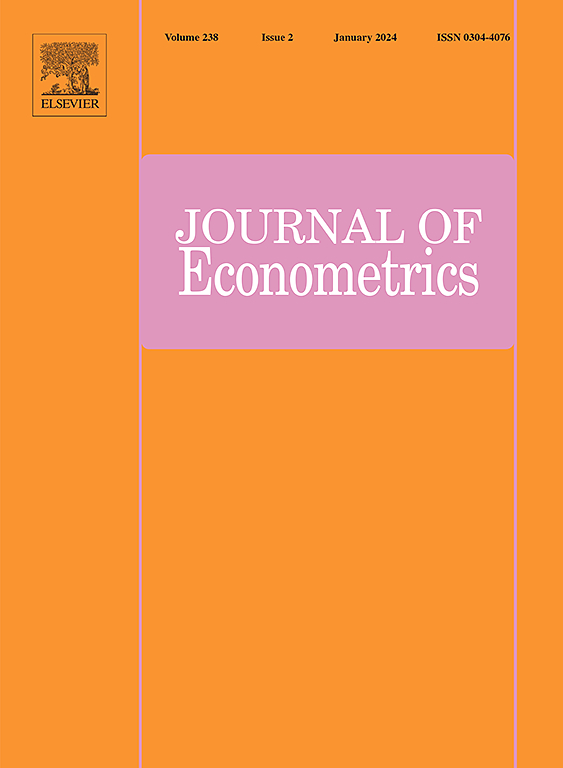Asymptotic theory of the best-choice rerandomization using the Mahalanobis distance
IF 4
3区 经济学
Q1 ECONOMICS
引用次数: 0
Abstract
Rerandomization, a design that utilizes pretreatment covariates and improves their balance between different treatment groups, has received attention recently in both theory and practice. From a survey by Bruhn and McKenzie (2009), there are at least two types of rerandomization that are used in practice: the first rerandomizes the treatment assignment until covariate imbalance is below a prespecified threshold; the second randomizes the treatment assignment multiple times and chooses the one with the best covariate balance. In this paper we will consider the second type of rerandomization, namely the best-choice rerandomization, whose theory and inference are still lacking in the literature. In particular, we will focus on the best-choice rerandomization that uses the Mahalanobis distance to measure covariate imbalance, which is one of the most commonly used imbalance measure for multivariate covariates and is invariant to affine transformations of covariates. We will study the large-sample repeatedly sampling properties of the best-choice rerandomization, allowing both the number of covariates and the number of tried complete randomizations to increase with the sample size. We show that the asymptotic distribution of the difference-in-means estimator is more concentrated around the true average treatment effect under rerandomization than under the complete randomization, and propose large-sample accurate confidence intervals for rerandomization that are shorter than that for the completely randomized experiment. We further demonstrate that, with moderate number of covariates and with the number of tried randomizations increasing polynomially with the sample size, the best-choice rerandomization can achieve the ideally optimal precision that one can expect even with perfectly balanced covariates. The developed theory and methods for rerandomization are also illustrated using real field experiments.
利用马氏距离的最佳选择再随机化的渐近理论
重新随机化是一种利用预处理协变量并改善其在不同治疗组之间的平衡的设计,近年来在理论和实践中都受到关注。Bruhn和McKenzie(2009)的一项调查显示,实践中至少有两种类型的再随机化:第一种是对治疗分配进行再随机化,直到协变量失衡低于预设阈值;第二种方法将治疗分配随机化多次,并选择协变量平衡最佳的治疗分配。本文将考虑第二种类型的再随机化,即最佳选择再随机化,其理论和推理在文献中仍然缺乏。特别是,我们将重点关注使用马氏距离来测量协变量不平衡的最佳选择再随机化,这是最常用的多变量协变量不平衡度量之一,并且对协变量的仿射变换是不变的。我们将研究最佳选择再随机化的大样本重复抽样特性,允许协变量的数量和尝试完全随机化的数量随着样本量的增加而增加。我们证明了在再随机化条件下,均值差估计量的渐近分布比完全随机化条件下更集中在真实平均治疗效果周围,并提出了比完全随机化条件下更短的大样本精确置信区间。我们进一步证明,在适度数量的协变量和尝试随机化的数量随样本量多项式增加的情况下,最佳选择再随机化可以实现理想的最优精度,即使在完全平衡的协变量下也是如此。本文还通过实际的现场实验说明了重新随机化的理论和方法。
本文章由计算机程序翻译,如有差异,请以英文原文为准。
求助全文
约1分钟内获得全文
求助全文
来源期刊

Journal of Econometrics
社会科学-数学跨学科应用
CiteScore
8.60
自引率
1.60%
发文量
220
审稿时长
3-8 weeks
期刊介绍:
The Journal of Econometrics serves as an outlet for important, high quality, new research in both theoretical and applied econometrics. The scope of the Journal includes papers dealing with identification, estimation, testing, decision, and prediction issues encountered in economic research. Classical Bayesian statistics, and machine learning methods, are decidedly within the range of the Journal''s interests. The Annals of Econometrics is a supplement to the Journal of Econometrics.
 求助内容:
求助内容: 应助结果提醒方式:
应助结果提醒方式:


